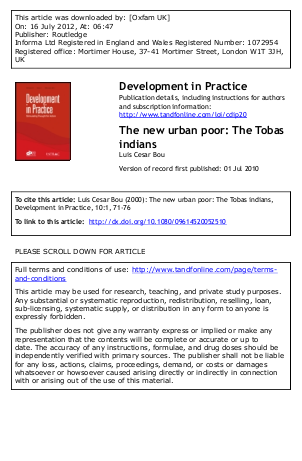
The Tobas belong to a large group of indigenous people known as the guaycuruÂes. Originally they occupied an extensive part of northern Argentina in the Chaco (aymara for hunting ground) area, which includes the provinces of Chaco, Santa FeÂ, Santiago del Estero, Salta, and Formosa, reaching as far as neighbouring Paraguay. Chaco was once covered with immense forests which contained valuable plants and tree species such as the quebracho. The Tobas were a nomadic group who lived by hunting, ® shing, and gathering. They later adopted some Andean cultural traditions such as ceramics, weaving, and basket-making (Canals Frau 1987) . Since 1880, the Argentinian government has been systematically occupying indigenous lands. In Chaco, the last major confrontation between the guaycuruÂes and the army was in 1919. The indigenous people were decimated both by the army’ s superior ® repower, but also by alcohol. Their ancestral hunting grounds were turned into vast estates mainly for the timber trade. One London-based company alone, La Forestal, held over two million hectares in the Chaco region (Gori 1983). The extraction of tannin from the quebracho, the production of sleepers for the railways, and wood for fences, reduced the vast forest into an enormous wasteland within a few decades. A quebracho tree takes 100 years to grow but no one was interested in so long a wait ¼ With great dif® culty the Tobas adapted to their new, harsher situation. Few worked in the timber industry because they regarded the quebracho as sacred, and much of their disagreement with the white people arose from their plunder of the forests. The Tobas continued ® shing and were eventually able to sell their crafts, though there were few tourists to buy them. They also took on wage-labour or domestic jobs; many women became house-servants for the white colonialists. The emerging cotton industry provided the best opportunities for subsistence. Each year, a huge number of Tobas people took part in the cotton harvesting which provided a substantial cash income. The money was handled by the women and would cover all the most urgent needs until the next harvest.
Resource collections
- UN Habitat - Urban Response Collection
- Urban Response - Urban Crisis Preparedness and Risk Reduction
- Urban Response Collection - Community Engagement and Social Cohesion
- Urban Response Collection - Economic Recovery
- Urban Response Collection - Environment and Climate Change
- Urban Response Collection - Housing, Land and Property
- Urban Response Collection - Urban Crisis Response, Recovery and Reconstruction
- Urban Response Collection - Urban Resilience